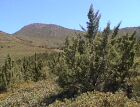
King Creek basin before the 2003 fires: a large cypress tree on the right, a large grove in the distance on the left and Cuyamaca Peak on the horizon [Walter T. Hansen].

Seed cones and foliage [C.J. Earle, 2009.02.08].
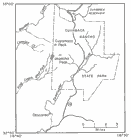
Distribution; "E" signifies an extirpated occurrence (Griffin and Critchfield 1972).

A small proportion of trees show a natural fastigiate growth form [C.J. Earle, 2009.02.08].
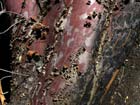
Bark on a fire-killed tree about 42 cm diameter, in King Creek Research Natural Area, CA [C.J. Earle, 2004.04.07].
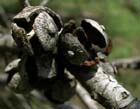
Open cones on a fire-killed tree in King Creek Research Natural Area, CA [C.J. Earle, 2004.04.07].
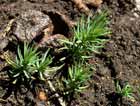
Cypress seedlings about 2 cm tall in King Creek Research Natural Area, CA [C.J. Earle, 2004.04.07].

Cypress seedlings in King Creek Research Natural Area, CA [C.J. Earle, 2004.04.07].

Excavated seedling, about 6 cm long overall, in King Creek Research Natural Area, CA [C.J. Earle, 2004.04.07].

Conservation Status

Hesperocyparis stephensonii
(C.B.Wolf) Bartel (2009)
Common names
Cuyamaca cypress (American Forests 2000).
Taxonomic notes
Synonymy: see POWO (accessed 2023.12.16). See Hesperocyparis arizonica for discussion of the relationship between various taxa assigned by some authors to H. arizonica. See Hesperocyparis for a discussion of the relationship between this and other, closely related Hesperocyparis taxa in northwest Mexico and the adjacent Southwest U.S.
Description
Trees, erect or spreading, 10-16 m tall, up to 10 m crown spread, up to 70 cm dbh, with a straight central trunk. Bark thin, cherry-red, smooth, exfoliating, not fibrous. Branchlets 10(-20) mm long, 1.5-2 mm thick, roughly quadrangular. Year-0 leaves 1 × 1 mm, acute, abaxially rounded, often with an active gland esp. on vigourous shoots over 1 year old. Older leaves continue to grow and may attain 4 × 10 mm with a free tip 2-3 mm long, with resin gland at base of free tip. Resin clear, drying to white. Leaf margins ciliate or fimbriate under a 10X lens. Glaucous foliage has a lemony odor when crushed. Pollen cones 2 × 2-4 mm, cylindrical or slightly tapered, with (8-)10-12(-14) scales, each with 3-5 pollen sacs. Seed cones at tips of branchlets, green and 3 mm diam. prior to pollination, turning brown and growing to 10 mm diam. at end of first season, then dull gray, rough or warty, globular, up to 25 mm diam. at maturity (end of 2nd season). Cone scales 6(-8) with a conspicuous 3-4 mm tall conical umbo. Cones bear 100-125 seeds, not glaucous, very dark brown, 5(-8) × 5(-8) mm, with a light tan hilum 2-3 mm long. Seedlings with 3-4 cotyledons, linear, blunt, 10-13 mm long (Wolf 1948). See García Esteban et al. (2004) for a detailed characterization of the wood anatomy.
Distribution and Ecology
USA: California and Mexico: Baja California. This rarest of named cypresses is "[K]nown only from a few scattered trees on the headwaters of King Creek on the southwest side of Cuyamaca Peak, San Diego County" (Peattie 1950).
Data from USGS (1999).
It was formerly well represented at the King Creek Research Natural Area in Cleveland National Forest. Alas, this site was devastated in the great Southern California fires of October 2003, experiencing a reported 70% mortality (100% throughout most of its former range, with a few pockets of survivors). The future of the species appears now to rest in the hands of those charged with restoring the site. At this time, that chiefly consists of supporting reestablishment of cypress (which has doubtless experienced such calamitous burns at intervals of a few hundred years in the past). As of April 2007, successful post-fire seedling establishment was observed in several locations within King Creek RNA, with dense stands of sapling up to about 0.7 m tall growing in the best sites.
Although the IUCN rated this species as "vulnerable" in their 1998 assessment (which has not been updated as of 2012.11.30), I believe that reassessment after the destruction caused by the 2003 fires would result in an "endangered" rating, and have so designated it.
Remarkable Specimens
The largest specimen is 11 m tall, dbh 57 cm, crown spread 9 m; in Cleveland National Forest, California (American Forests 2000). There's a pretty good chance this tree burned up in 2003, but there are also some large ornamental specimens in the area. I measured one very healthy tree at Woodward Mountain in Ramona that was approximately 12 m tall and 40 cm dbh.
As for ages, there are no reported data, but in view of the species' relatively vigorous growth, small population size, and high exposure to destructive fire, it appears likely that very few, if any trees exceed 100 years in age.
Ethnobotany
No data as of 2023.12.16.
Observations
You can find it at the King Creek Research Natural Area in Cleveland National Forest, but it's a long walk to a gloomy site where almost all trees are just charred snags. You can also occasionally see this species growing as an ornamental in the mountains of San Diego County. One good location is on the grounds of the California Department of Forestry fire station in Ramona (33.0085°N, 116.96143°W), and in the canyon just uphill of the location, on the slopes of Mt. Woodson. These trees probably represent a naturalized population from an ornamental seed source. Another small stand of relatively large trees can be found at Wildcat Spring, just north of the King Creek RNA.
You may also want to visit the nearby stand of H. forbesii.
Remarks
The epithet stephensonii remembers J. Burt Stephenson, District Ranger at Descanso, who collected specimens from these trees, I believe during the 1930's, and distributed them to several herbaria. One of these attracted the attenion of Carl Wolf, who collected the type specimen in 1938 and described the species in 1948, naming it for Mr. Stephenson, who had died in 1944 (Wolf 1948, Griffin and Critchfield 1972).
Citations
American Forests 2000. The National Register of Big Trees 2000. Washington, DC: American Forests.
Bartel 2009: described in Adams, R. P., J. A. Bartel and R. A. Price. 2009. A new genus, Hesperocyparis, for the cypresses of the western hemisphere. Phytologia 91(1):160-185.
See also
The species account at Threatened Conifers of the World.
USFS Fire Effects Information Service, accessed 2009.04.02.
Farjon (2005) provides a detailed account, with illustrations.








